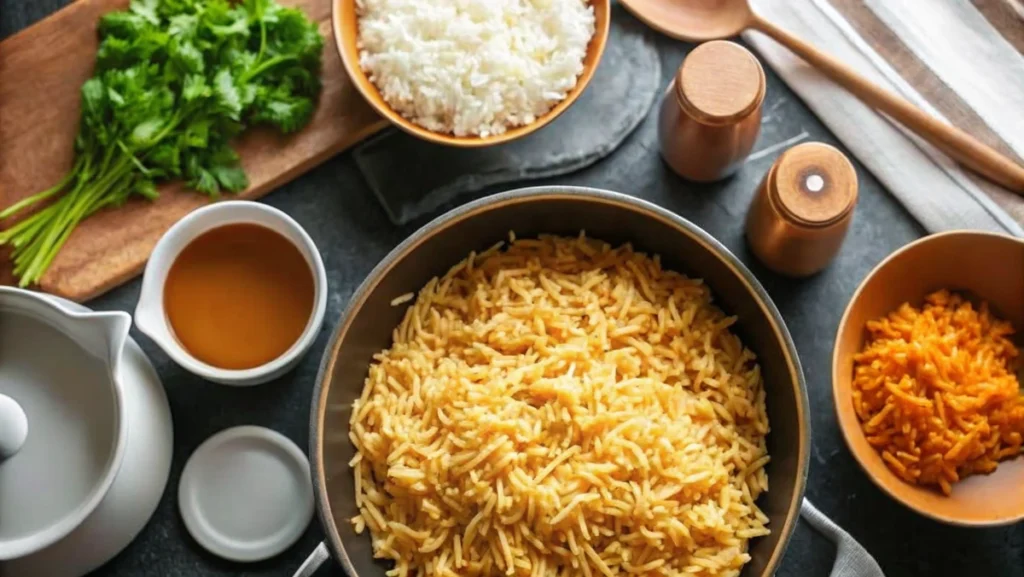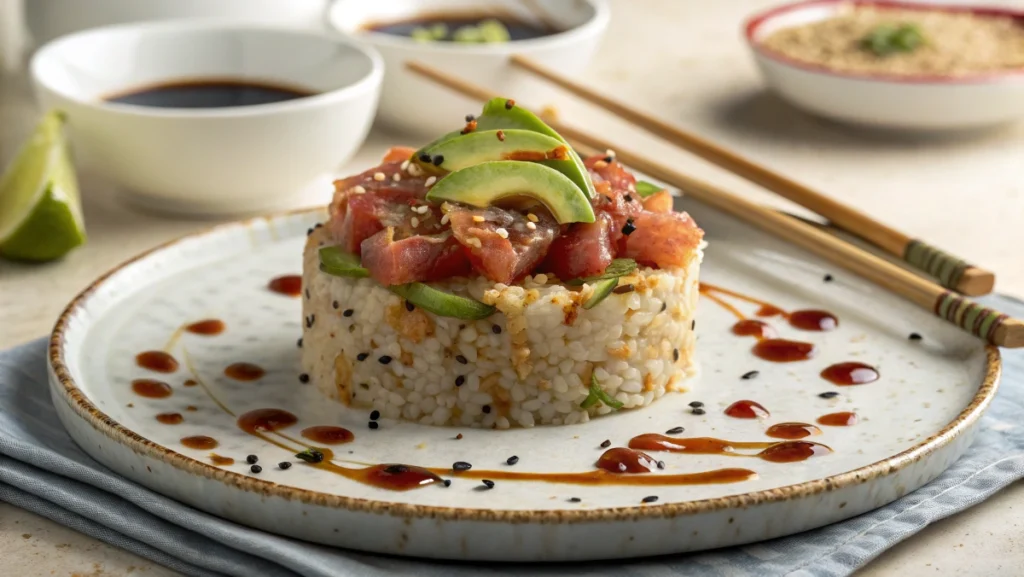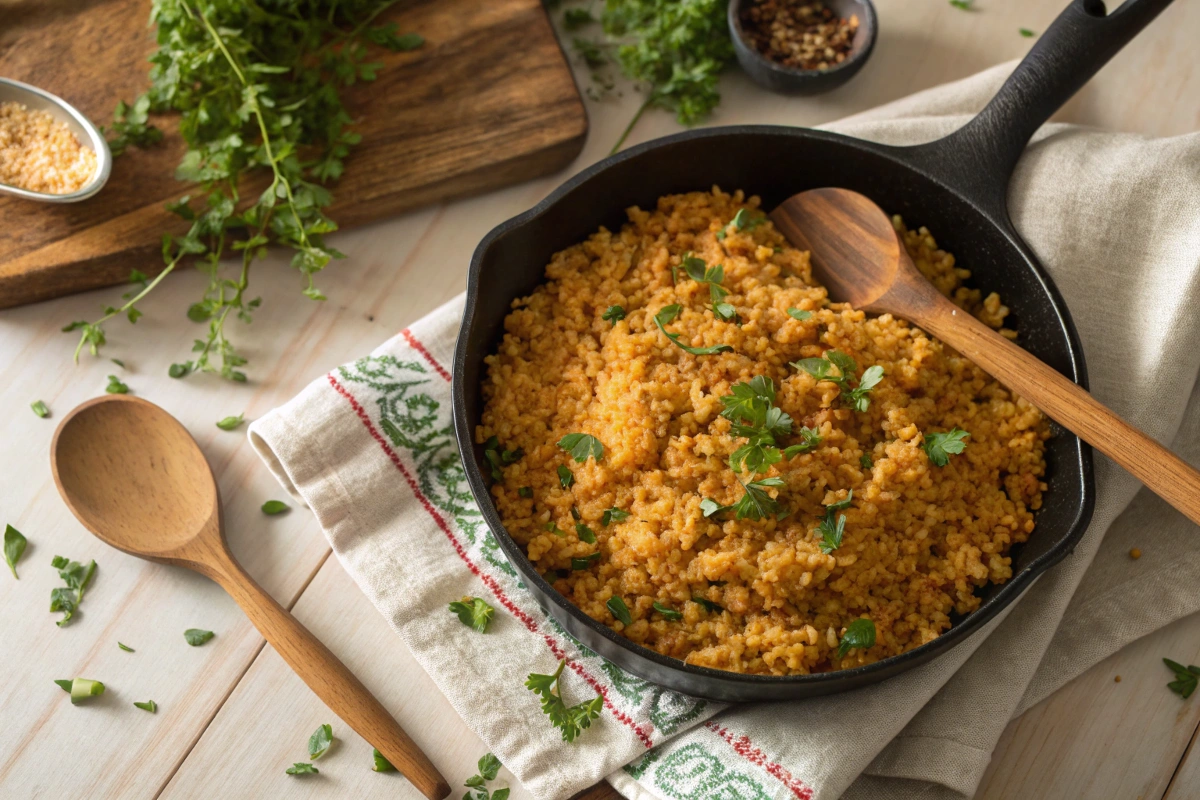Discover how the love for crispy rice recipe spans cultures, from Tehran’s tahdig to Valencia’s socarrat. Elevate your culinary skills with tips inspired by global rice cooker recipes, perfect for every occasion.
Table of contents
Imagine a spoonful of fluffy rice in a buttery, crispy shell. It’s a mix of textures that’s both simple and profound. This guide will help you master crispy rice, adding buttery richness and sour cream for depth.
Every bite will be a revelation, promising to delight your taste buds.

Key Takeaways
- Discover the global love affair with crispy rice and how to replicate it in your kitchen.
- Master the timing—learn how long to boil and fry your rice for that golden crisp.
- Find out why a well-seasoned skillet is your best friend for crispy rice recipe.
- Get the scoop on seasoning and how to incorporate decadent flavors like sour cream for unforgettable rice.
- Learn the secrets of storing and reheating for maximum crunch and freshness.
- Take inspiration from around the world and add international flair to your crispy rice dish.
The Secret to Perfect Crispy Rice: Ingredients You Need
Making perfect crispy rice recipe is all about the right ingredients. You need quality staples and a few secrets to get that golden crunch. Whether it’s a simple side or a poke bowl base, the journey starts here.
Choosing the Right Rice
For crispy rice recipe, choose grains that cook fluffy and distinct. Long grain Basmati or Jasmine rice is a classic choice. But, sushi rice or short-grain options can add a unique twist. These types of rice crisp up well when fried or baked.
Why Butter and Oil Make a Difference
Butter and oil are key for flavorful crispy rice recipe. They prevent sticking and add rich flavor. A mix of butter and oils like avocado oil ensures perfect crispiness without burning. This combo is vital for a golden crust.
Adding Flavor with Salt and Sour Cream
Salt boosts the rice’s natural flavor. Sour cream adds a tangy contrast, balancing the richness. This balance makes the dish unforgettable.
Choosing the right rice and understanding fats like butter and oil are key. Salt and sour cream add flavor and texture. Knowing how to mix these elements makes every bite of crispy rice delightful.
Preparing Your Rice for Cooking
To get crispy rice recipe just right, starting with the rice is key. We’ll cover the basics of getting rice ready for crispy rice. This includes rinsing rice and boiling water for rice correctly.
Rinsing: The First Critical Step
Rinsing rice is vital for crispy results. Sushi rice, with its high starch, is best for this. Rinsing removes extra starch, preventing stickiness. Rinse the rice in a colander under cold water until it’s clear.
This not only cleans the rice but also improves its texture. It helps each grain stay separate when fried.
Boiling Water: Getting the Temperature Right
Perfect rice starts with the right boiling water. The water should be between 350-375 degrees Fahrenheit. Add rinsed rice, seasoned with salt, to this water.
Boil the rice until it’s almost tender, about 20 minutes. Then, drain and cool it under cold water. This stops the cooking and prepares it for frying.
Here’s a quick summary in a table format. It outlines the steps and temperatures for preparing rice for crispy perfection:
| Step | Detail | Temperature/Time |
|---|---|---|
| Rinsing rice | Wash until water runs clear | N/A |
| Boiling water for rice | Add rice to boiling, salted water | 350-375°F / 20 minutes |
| Cooling Down | Rinse boiled rice under cold water | Cold water rinse |
By controlling these elements, you set the stage for crispy rice recipe. Make sure to follow these steps carefully. This will ensure your dish has a satisfying crunch.
Cooking Techniques for Crispy Rice
To get that perfect crispy base, you need to know the right techniques. From Vietnam to Spain, crispy rice is a favorite for its texture and taste.
The Importance of a Well-Seasoned Skillet
A well-seasoned skillet is key for crispy rice. It prevents the rice from sticking and tearing. Plus, it adds extra flavor to your dish.
Why Even Heat Distribution is Key
Even heat is vital for crispy rice recipe. Uneven heat can burn some parts and leave others raw. To avoid this, rotate the skillet every 3 to 4 minutes.
Let’s look at how important technique is in making crispy rice. For example, Tahdig recipes require careful steps for that perfect crispiness.
| Ingredient/Tool | Role in Crispy Rice Preparation | Specific Use |
|---|---|---|
| Well-seasoned skillet | Provides non-stick surface and flavor enhancement | Frying the rice with butter and oil mixture |
| Heat distribution | Prevents uneven cooking and burning | Rotating the skillet during cooking |
| Mixture of sour cream and cooked rice | Binds the rice, aiding in even layer formation | Mixed and spread at the bottom of the skillet |
| Butter and oil | Ensures crispy texture and rich flavor | Heated in the skillet before adding the rice mixture |
| Total cooking time | Ensures rice is crispy yet not overcooked | About 15 minutes, with frequent rotation |
By following these tips, you can make crispy rice that everyone will love. The secret is in the skillet and managing the heat.
Turning Leftovers into Crispy Delights
Make your leftover rice into a tasty treat with a few tricks. Crispy rice with leftovers is not only delicious but also helps reduce waste. Here’s how to turn old rice into a crispy snack.
Reviving Day-Old Rice
Start with day-old rice for the best results. It has less moisture than fresh rice. Use 2 cups of cold, cooked rice. Break up any clumps so each grain can crisp up well.
Heat a large skillet or wok to medium-high to high. Cook the rice undisturbed for 5 to 7 minutes. This will make the bottom layer golden and crispy.
Adjustments for Different Rice Types
The type of rice you use can change the texture and taste of your crispy rice. Brown rice adds fiber, while quinoa or farro offer different flavors. Make sure they have the same water-to-grain ratio and cooking time for the best results.
Here’s a table with cooking times and tips for different rice types:
| Rice Type | Cooking Time | Tips |
|---|---|---|
| White Rice | 5-7 minutes | Cook on high heat, stir minimally. |
| Brown Rice/Whole Grains | 7-10 minutes | Ensure extra drying time, slightly lower heat. |
| Quinoa/Farro | 5-7 minutes | Maintain high heat, stir occasionally. |
When making crispy rice, add flavors like Gochujang or rice wine vinegar. These will give your rice a unique taste. Add fresh cilantro or scallions at the end to add freshness.
Crispy rice with leftovers is more than just a meal. It’s a chance to be creative in the kitchen. It can be a side dish or a base for a salad. The possibilities are endless, from small skillet dishes to large baking trays.

Global Inspirations for Your Crispy Rice Dish
Exploring global crispy rice recipe dishes shows a wide range of flavors and cooking methods. Each culture uses its own ingredients and cooking ways to make crispy rice. This turns simple rice into a tasty, crunchy treat.
In Iran, tahdig is a dish where rice becomes a crunchy, golden crust. It’s often flavored with saffron and served over potatoes or bread. In Spain, socarrat is a toasted crust at the bottom of paella. It’s a key part of the dish’s authentic taste.
From Tahdig to Socarrat: A World of Crunch
Tahdig and socarrat show how crisping rice can make it gourmet. In Korea, nurungji is a snack or a comforting dish with water or broth. It’s known for its mild nutty taste.
In Japan, crispy rice is used in small rice cakes. These are fried and topped with spicy tuna or fresh sashimi. It’s a great mix of textures.
Incorporating International Flavors
In Latin America, there’s pegao and Colombia’s arroz con costra. Rice is layered with eggs to make a crispy crust. This shows how different cultures prepare crispy rice.
From using day-old rice to trying different oils for frying, the love for crispy rice is universal. It’s all about that satisfying crunch.
Whether making Jollof rice in West Africa or a crispy brown rice dish in the US, crispy rice is loved worldwide. Each dish, from Chinese guoba to Spanish socarrat, offers a variety of flavors and textures. They all share the joy of that perfect crunch.
Frying vs. Baking: Exploring Cooking Methods
Choosing the right method is key to making perfect crispy rice. Whether for sushi or a side dish, frying or baking can change the taste and texture. Let’s explore the benefits of each method.
When to Fry for the Best Crunch
Frying crispy rice is the top choice for a golden crunch. Deep frying makes the rice crisp and satisfying. It involves heating oil and adding rice in batches for even crispiness.
The secret to great frying is the right oil temperature and timing. This ensures the rice turns golden without burning.
Baking: A Healthier Alternative?
Baking crispy rice is a healthier option than frying. It uses less oil, making it lower in fat. Cooked rice is spread on a baking sheet, drizzled with oil, and baked at 300 degrees Fahrenheit.
This method produces crispiness without the oil’s heaviness. It’s a great choice for those watching their fat intake.
Here’s a comparison of the two methods:
| Cooking Method | Calories per Serving | Total Fat | Preparation Time |
|---|---|---|---|
| Frying | 91 | 5g | 2-3 minutes per side |
| Baking | Less than frying | Lower than frying | Varies by oven efficiency, approximate same total time when pre-heated |
Both methods have their advantages. Frying offers rich flavor and crisp texture, while baking is healthier. Your choice depends on your diet and preferences. Crispy rice is a tasty addition to many dishes.
In conclusion, whether frying or baking, the goal is the crispy finish. Using these cooking methods for crispy rice will enhance your dishes and satisfy your cravings.
Crispy Rice: Elevating a Simple Grain to Gourmet Status
Turning rice into gourmet crispy rice is more than just adding ingredients. It’s about mastering crispy rice techniques and perfecting crispy rice texture. This journey begins with understanding and executing each cooking step precisely.
| Aspect | Details |
|---|---|
| Rice Type and Cooking Ratio | Use short-grain or sushi rice for its high starch content. Cook with a 1:1.25 rice-to-water ratio. |
| Seasoning and Cooling | Mix 1 tablespoon rice vinegar, 1 teaspoon sugar, and 1/2 teaspoon salt. Cool the rice in the fridge for at least 1 hour. |
| Portioning and Shaping | Divide chilled rice into portions. Form shapes about 1/2 inch thick for even crisping. |
| Crisping Process | Heat a skillet with 2–3 tablespoons of a high smoke point oil. Crisp each rice shape for 3–4 minutes on each side until golden-brown. |
| Topping and Flavor Enhancements | Add toppings like spicy tuna, avocado, and ponzu sauce for extra flavor and visual appeal. |
The journey from simple grain to gourmet crispy rice shows the power of culinary creativity. It’s not just about choosing the right rice and seasoning. The cooking and crisping techniques are key to the perfect texture.
Every step, from seasoning to crisping, adds to the dish’s quality and appeal. Whether for a dinner party or a weekday meal, mastering these elements ensures a dish that’s as pleasing to look at as it is to eat.
—
These refined skills aim to enhance taste and look, ensuring a high-quality dining experience. Gourmet crispy rice is a great example of how traditional ingredients can be reimagined into modern culinary delights.
The Role of Condiments and Toppings
Discovering the perfect balance of condiments and crispy rice toppings can make your dish amazing. These elements are key in making each bite more flavorful. They are essential for a delicious crispy rice dish.
Enhancing Flavor with Sauces
Adding flavorful condiments like soy sauce, sesame oil, or chili oil can make your dish taste better. For a spicy and sweet mix, try gochujang paste. It adds a unique flavor that sets your crispy rice apart.
Creative Topping Ideas
When it comes to crispy rice toppings, you can get creative. Try adding soft avocado slices or spicy kimchi for flavor and texture. Fresh herbs like mint or proteins like raw fish or king oyster mushrooms can make your dish stand out.
Following these tips, making a dish with crispy rice toppings is fun. You can mix savory, sweet, or spicy flavors. This ensures every meal is both healthy and tasty. Whether you’re hosting guests or making a quick dinner, these ideas add variety to your cooking.
Common Mistakes to Avoid
When making crispy rice, it’s important to avoid common mistakes. These mistakes can ruin your dish. Knowing what to avoid helps you get the right texture and flavor.
Overcrowding the Pan
One big mistake is avoiding rice overcrowding. When there’s too much rice, steam builds up. This steam stops the rice at the bottom from getting crispy.
To fix this, use a wide skillet. Spread the rice thinly. This lets it cook evenly and get crispy.
Stirring Too Frequently
It’s tempting to stir the rice a lot. But, this is a mistake. The rice needs to stay in contact with the pan to get crispy.
Let the rice sit for a few minutes before stirring. This helps create a crunchy layer.
Fixing these mistakes takes the right technique and patience. Here’s a comparison of the right and wrong ways to cook crispy rice:
| Aspect | Proper Method | Improper Method |
|---|---|---|
| Rice to Water Ratio | 1 cup rice to 2 cups water | 1 cup rice to 1 cup water |
| Cooking Temperature | Medium-high heat | Low heat |
| Stirring Frequency | Stir once midway | Frequent stirring |
| Rice Resting Time | 10-15 minutes | No resting |
| Use of Oil | 0.5 teaspoons per 0.5 cups of rice | No oil |
By avoiding these mistakes and using the right techniques, you can make perfect crispy rice. Each grain will be toasted and crunchy.
Storing and Reheating Tips
Keeping your crispy rice tasty the next day is more than just tossing leftovers in the fridge. It’s about storing it right, reheating it well, and keeping its crunch. Here’s how to keep your crispy rice crunchy and follow the best storage tips.
Maximizing Crunch On The Next Day
To keep your crispy rice crunchy, reheating it right is key. Don’t use the microwave, as it can make it soggy. Instead, reheat it on the stove or in the oven.
For oven reheating, spread the rice on a baking sheet thinly. Warm it at 350 degrees Fahrenheit until it’s hot and crispy again. On the stovetop, reheat it in a skillet over medium heat. You can add a tablespoon of oil to make it crisper.
Make sure the rice gets to at least 165 degrees Fahrenheit. This is important for food safety.
Best Practices for Storage
Storing crispy rice right is key to keeping its texture and safety. Cool it to room temperature first. Then, put it in an airtight container and refrigerate it.
This stops bacteria from growing, which is bad between 40 and 140 degrees Fahrenheit. Your rice will stay safe to eat for up to 3 days, as the USDA says. For longer storage, freeze it in freezer-safe containers or bags for up to 6 months. This keeps its texture good.
| Storage Option | Temperature | Duration | Texture Preservation |
|---|---|---|---|
| Refrigeration | Below 40°F | 3-4 days | Good |
| Freezing | 0°F | Up to 6 months | Excellent |
By following these tips, your crispy rice will stay tasty and safe. Don’t reheat it more than once, as it can lose texture and safety. Always keep it in a dry place to keep its crunch.
FAQs
What type of rice is best for making perfect crispy rice?
Long grain white rice is the best for crisping. Carolina Gold rice is a top pick. But, you can use any leftover rice, like basmati, jasmine, or sushi rice.
Why are butter and oil important in making crispy rice?
Butter and oil stop the rice from sticking to the pan. They also add richness and flavor as the rice fries.
How does adding salt and sour cream enhance the flavor of crispy rice?
Kosher salt makes the rice water flavorful. Sour cream adds tanginess and creaminess. It helps bind the rice for a richer taste.
What is the significance of rinsing rice before cooking?
Rinsing rice removes excess starch. This is key to avoiding a gummy texture. It helps the rice crisp up better.
How do you achieve the right temperature when boiling water for rice?
First, bring the water to a boil. Then add rice and season with Kosher salt. This ensures even cooking and flavor.
Why is a well-seasoned skillet important for cooking crispy rice?
A seasoned skillet or nonstick pan prevents sticking. It also helps distribute heat evenly. This is vital for a crispy bottom layer.
How does even heat distribution contribute to the perfect crispy rice?
Even heat makes the rice’s bottom layer crisp evenly. This ensures a consistent golden brown.
Can you use leftover rice to make crispy rice, and how?
Yes, leftover rice is great for crispy rice. Break up any clumps. Then, form a compact layer in the skillet for that golden crunch.
What are some global dishes that celebrate crispy rice?
Crispy rice is loved worldwide. Try dishes like Tahdig from Iran, Socarrat from Spain, and Norungji from Korea.
When is it best to fry rice for maximum crunch?
Fry rice in butter and oil for a deep golden, crispy texture. This method allows for browning without disturbance.
Is baking a healthier option for making crispy rice?
Baking is a healthier choice as it uses less oil. But, it might not give the same crunch as frying.
How can condiments and toppings enhance my crispy rice dish?
Add soy sauce, sesame oil, or mayo for flavor. Toppings like vegetables or proteins can also boost taste and look.
What common mistakes should I avoid when making crispy rice?
Don’t overcrowd the pan to ensure even crisping. Also, avoid stirring too much. This helps create a crispy bottom layer.
What are the best practices for storing and reheating crispy rice?
Cool the rice completely and store it in an airtight container. Reheat it on the stovetop or in the oven. This will help restore some crispiness.
Conclusion
Starting your journey to crispy rice mastery in your kitchen is not just possible—it’s a fun adventure. We’ve covered the key steps to perfecting crispy rice at home. This includes picking the right ingredients, like two cups of short-grain rice and four cups of water.
By following our tips, you’ve learned how to prepare the rice. This includes rinsing it and mixing it with soy sauce and sesame oil. This sets the stage for the crispy rice finale.
We’ve talked about the importance of not overcrowding your pan. Also, frying the rice for 3 to 4 minutes on each side is key. Using day-old rice makes it even crisper, just like in Japanese Omurice and Korean Bibimbap.
Making perfect crispy rice is more than just a recipe. It’s about knowing how ingredients, temperature, and timing work together. Now, you’re ready to make your next meal special. Turn a simple side dish into a gourmet delight.
With this knowledge, you can satisfy everyone’s hunger. Go ahead and impress your guests with your crispy rice skills.

